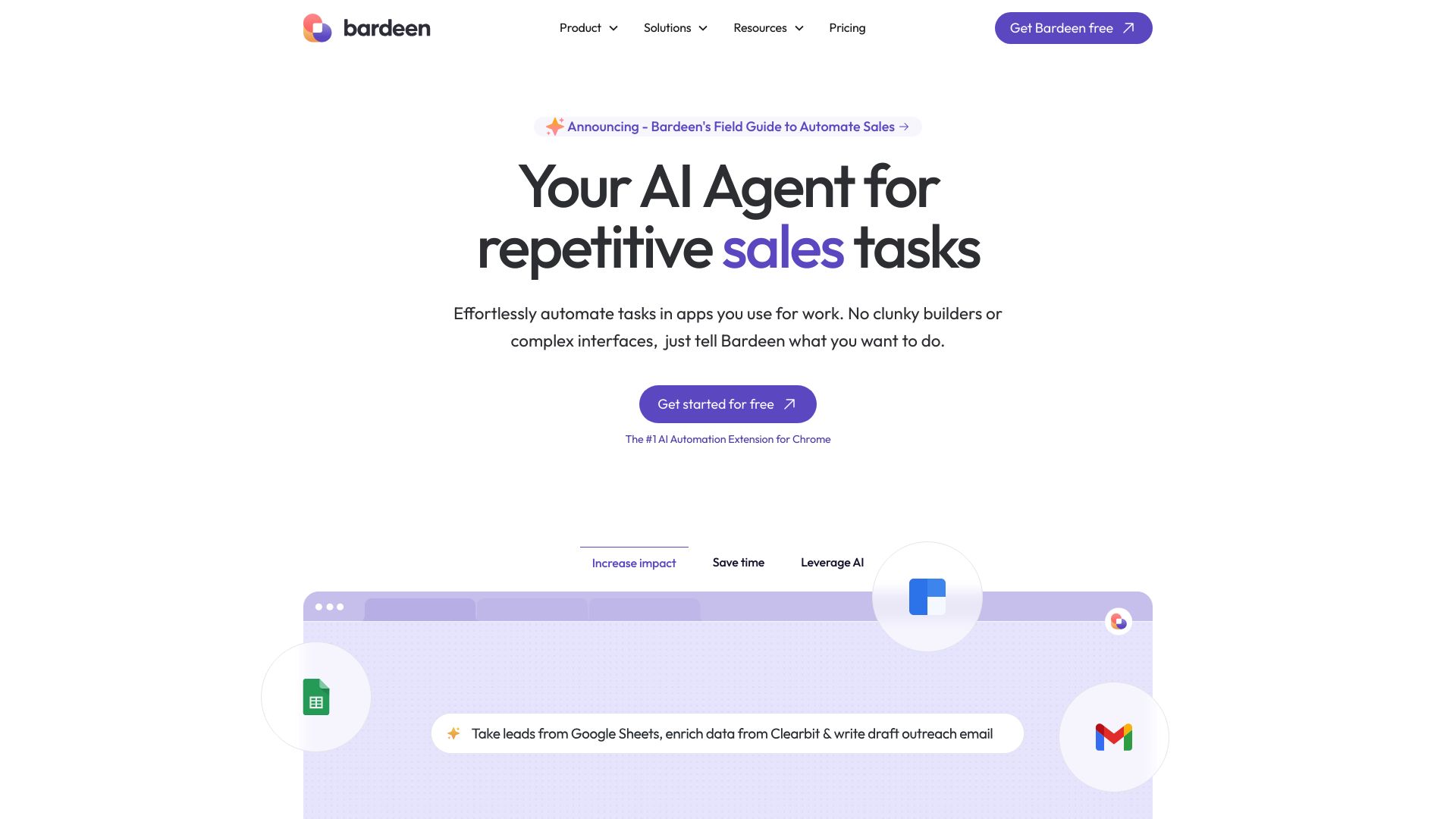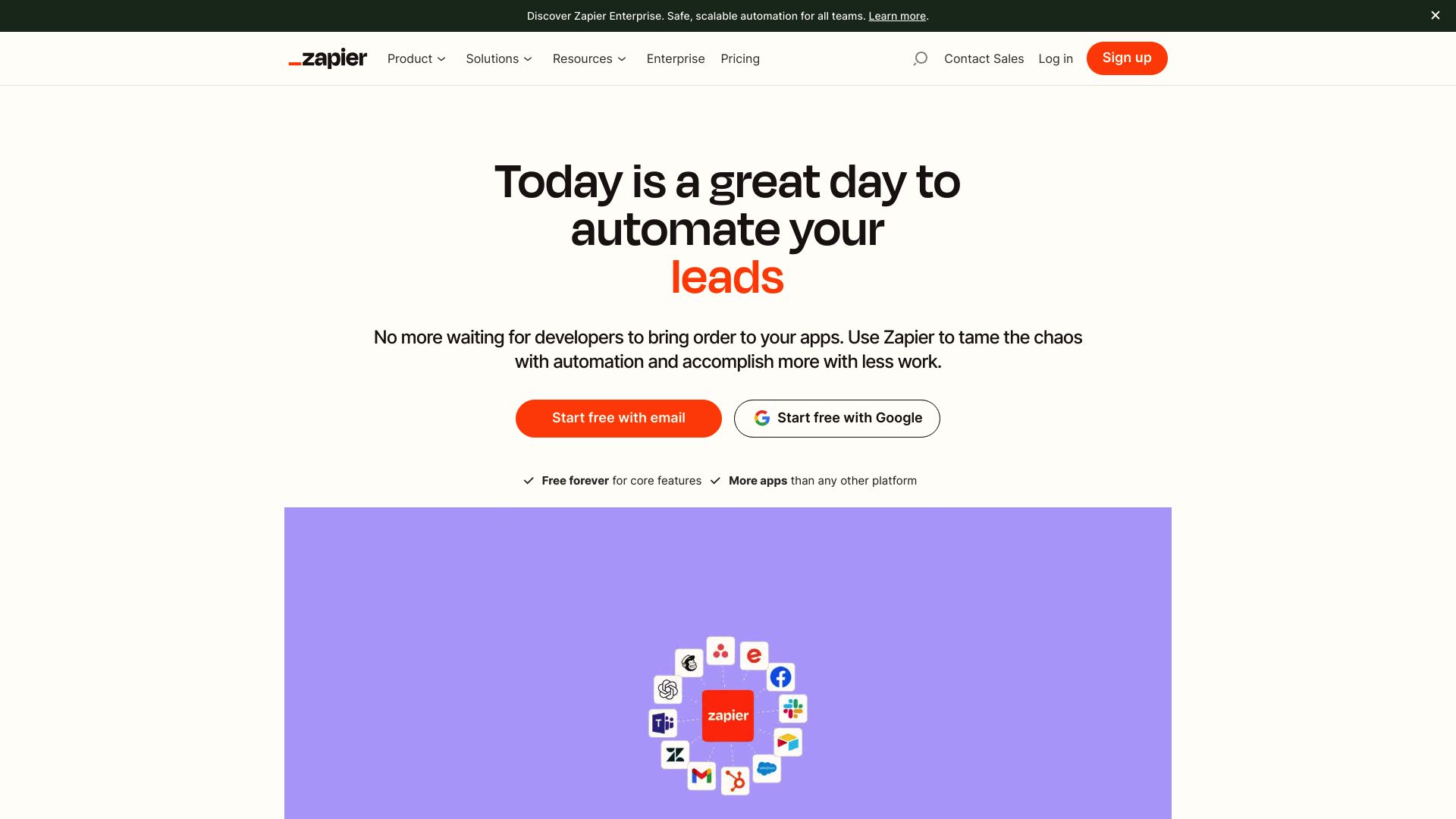AI-powered automation tools revolutionize how businesses streamline workflows and boost productivity. This comparison explores Bardeen AI vs. Zapier, and SmythOS, three leading platforms that approach task automation differently. Bardeen AI specializes in browser-based automations with AI enhancements, while Zapier excels in connecting diverse web applications.
SmythOS emerges as a comprehensive solution, combining powerful AI capabilities with scalable, enterprise-ready features. We’ll examine each platform’s strengths, limitations, and ideal use cases to help you choose the best tool for your automation needs.
Bardeen AI Overview
Bardeen AI revolutionizes web automation through its innovative Chrome extension. This no-code platform empowers users to create custom workflows, called Playbooks, that automate repetitive online tasks. Bardeen’s visual builder allows anyone to construct complex automations without programming expertise, democratizing efficiency gains previously reserved for technical teams.
The platform shines in its ability to connect popular web services like Gmail, Google Sheets, and LinkedIn. Users can craft personalized solutions by combining pre-built actions and triggers into streamlined processes. Bardeen enhances these automations with AI-powered features such as text classification, data extraction, and content generation, leveraging models like GPT-3 to augment human capabilities.
Bardeen AI revolutionizes web automation through its innovative Chrome extension. This no-code platform empowers users to create custom workflows… that automate repetitive online tasks.


Bardeen AI distinguishes itself through its focus on human-in-the-loop interactions. Rather than aiming for fully autonomous agents, Bardeen’s approach allows users to guide automations, validate data, and provide inputs when needed. This participative model ensures that automations remain aligned with user intent and can adapt to nuanced scenarios that pure AI might struggle with.
Bardeen AI distinguishes itself through its focus on human-in-the-loop interactions… allows users to guide automations, validate data, and provide inputs when needed.
While Bardeen excels in browser-based task automation, it has limitations. The platform lacks features for hosting independent agents or scaling to enterprise-wide deployments. Its strength lies in personal and small team productivity enhancements rather than large-scale, hands-off automation. Additionally, Bardeen’s reliance on browser extensions may limit its applicability in environments with strict security policies.
Bardeen AI integrates seamlessly with popular web applications and services through OAuth, ensuring secure connections. The platform also offers collaborative features for team environments, allowing shared workspaces and analytics dashboards for business and enterprise plans. However, users seeking advanced capabilities like autonomous problem-solving or multi-agent collaboration may find Bardeen’s offerings limited compared to more comprehensive AI development platforms.
Zapier Overview
Zapier connects over 6,000 apps to automate workflows without coding. Users create “Zaps” that link triggers in one app to actions in another, streamlining repetitive tasks across platforms.


Zapier’s visual editor enables non-technical users to build complex automations. Drag-and-drop interfaces and pre-built templates accelerate setup for common scenarios like syncing customer data or posting social media updates. For developers, Zapier offers tools to create custom integrations and leverage webhooks for advanced workflows.
Zapier connects over 6,000 apps to automate workflows without coding. Users create “Zaps” that link triggers in one app to actions in another, streamlining repetitive tasks across platforms.
The platform excels at connecting disparate systems, bridging gaps between popular business tools like G Suite, Slack, and Salesforce. This flexibility makes Zapier valuable for streamlining operations across departments. However, Zapier focuses on app integrations rather than building conversational AI agents or complex decision-making systems.
While powerful for automations, Zapier has limitations. It lacks built-in natural language processing or machine learning capabilities. Users expecting advanced AI features may find the platform’s scope too narrow. Additionally, complex workflows can become difficult to manage as the number of steps and connected apps increases.
Zapier’s pricing model scales based on the number of tasks and connected apps, which can become costly for high-volume users. Despite these constraints, Zapier remains a go-to solution for businesses seeking to boost productivity through no-code automation.
Feature Comparison
Bardeen AI and Zapier offer distinct approaches to workflow automation, with key differences in their core components and security features. Bardeen AI focuses on browser-based automations through its Chrome extension, emphasizing human-in-the-loop interactions and AI-enhanced capabilities. It provides a visual no-code builder for creating custom workflows called Playbooks, integrating AI functionalities like text classification and data extraction.
Zapier, in contrast, excels in connecting a vast array of web applications, allowing users to create automated workflows between different services without requiring a browser extension. While Zapier offers a robust platform for app integrations, it lacks the AI-centric features found in Bardeen AI. Zapier’s strength lies in its extensive library of app connections and its ability to automate tasks across multiple platforms, but it doesn’t offer the same level of AI-powered enhancements or browser-specific automations as Bardeen AI.
In terms of security, both platforms offer OAuth authentication for integrations, but Bardeen AI’s approach to data handling within the browser environment may provide additional security benefits for certain use cases. However, Zapier’s long-standing presence in the market has led to more established enterprise-grade security features and compliance certifications, which may be crucial for larger organizations or those in regulated industries.
Feature Comparison Table
| Bardeen AI | Zapier | SmythOS | |
|---|---|---|---|
| CORE FEATURES | |||
| AI Agents | ✅ | ❌ | ✅ |
| Hosted Agents (Dev, Production) | ✅ | ❌ | ✅ |
| Memory & Context | ❌ | ❌ | ✅ |
| Autonomous Agents | ❌ | ❌ | ✅ |
| Explainability & Transparency | ✅ | ❌ | ✅ |
| Debug Tools | ❌ | ✅ | ✅ |
| Multimodal | ❌ | ❌ | ✅ |
| Problem-Solving Capabilities | ❌ | ❌ | ✅ |
| Multi-Agent Collaboration | ❌ | ❌ | ✅ |
| Human-AI Interaction | ✅ | ❌ | ✅ |
| Audit Logs for Analytics | ❌ | ✅ | ✅ |
| Agent Work Scheduler | ✅ | ❌ | ✅ |
| SECURITY | |||
| Constrained Alignment | ❌ | ❌ | ✅ |
| IP Control | ❌ | ❌ | ✅ |
| COMPONENTS | |||
| Foundation AIs | ❌ | ❌ | ✅ |
| Huggingface AIs | ❌ | ❌ | ✅ |
| Zapier APIs | ❌ | ✅ | ✅ |
| Classifiers | ✅ | ❌ | ✅ |
| Logic | ❌ | ❌ | ✅ |
| Data Lakes | ❌ | ❌ | ✅ |
| DEPLOYMENT OPTIONS (EMBODIMENTS) | |||
| Deploy as API | ❌ | ✅ | ✅ |
| Deploy as Webhook | ❌ | ✅ | ✅ |
| Staging Domains | ❌ | ✅ | ✅ |
| Production Domains | ❌ | ✅ | ✅ |
| API Authentication (OAuth + Key) | ❌ | ✅ | ✅ |
| Deploy as Site Chat | ❌ | ❌ | ✅ |
| Deploy as Scheduled Agent | ✅ | ❌ | ✅ |
| Deploy as GPT | ❌ | ❌ | ✅ |
| DATA LAKE SUPPORT | |||
| Hosted Vector Database | ❌ | ❌ | ✅ |
| Sitemap Crawler | ❌ | ❌ | ✅ |
| YouTube Transcript Crawler | ✅ | ❌ | ✅ |
| URL Crawler | ❌ | ❌ | ✅ |
| PDF Support | ✅ | ❌ | ✅ |
| Word File Support | ❌ | ❌ | ✅ |
| TXT File Support | ❌ | ❌ | ✅ |
Best Alternative to Bardeen AI and Zapier
SmythOS emerges as the superior alternative to Bardeen AI and Zapier, offering a comprehensive AI automation platform that combines the best of both worlds while adding powerful new capabilities. Our platform excels in creating and deploying AI agents with unparalleled ease and flexibility.
Unlike Bardeen AI’s browser-centric approach or Zapier’s focus on app integrations, SmythOS provides a versatile environment for building sophisticated AI agents that can operate autonomously across various deployment options. We offer a visual drag-and-drop interface that simplifies complex AI workflow creation, making advanced automation accessible to users of all skill levels.
SmythOS provides a versatile environment for building sophisticated AI agents that can operate autonomously across various deployment options.
SmythOS stands out with its robust AI capabilities, including support for multiple AI models, memory and context retention, and multi-agent collaboration. These features enable the creation of intelligent systems that can handle complex tasks and adapt to changing scenarios — capabilities not found in either Bardeen AI or Zapier.
Our platform’s extensive integration ecosystem rivals and surpasses Zapier’s offerings, while also incorporating AI-enhanced functionalities that Bardeen AI strives for. SmythOS users can seamlessly connect to a wide array of APIs, data sources, and external services, creating truly interconnected and intelligent automation solutions.
SmythOS users can seamlessly connect to a wide array of APIs, data sources, and external services, creating truly interconnected and intelligent automation solutions.
With SmythOS, we’ve eliminated the limitations of browser-based automation and simple app connections, opening up a world of possibilities for AI-driven automation across industries and use cases. Our platform’s scalability, advanced security features, and diverse deployment options make it the ideal choice for businesses seeking a future-proof automation solution that grows with their needs.
Conclusion
Bardeen AI, Zapier, and SmythOS each offer unique approaches to workflow automation and AI integration. Bardeen AI excels in browser-based task automation with its Chrome extension, providing a human-in-the-loop model that suits users who prefer guided interactions. Zapier’s strength lies in its vast array of app integrations, making it ideal for connecting disparate systems without coding. However, both platforms have limitations in advanced AI capabilities and scalability for enterprise-wide deployments.
SmythOS emerges as the superior choice, combining the best of both worlds while addressing their shortcomings. Our platform offers a visual builder for creating AI agents without coding, similar to Bardeen’s approach, but extends far beyond browser-based automation. We provide hosted agents for development and production environments, enabling seamless scaling from prototypes to enterprise-level solutions. Unlike Zapier, SmythOS incorporates advanced AI capabilities, including natural language processing, multimodal interactions, and autonomous problem-solving.
What sets SmythOS apart is its versatility and power. We support multi-agent collaboration, allowing complex workflows that mimic human teams. Our platform integrates with a wide range of AI models and APIs, rivaling Zapier’s connectivity while adding the dimension of AI-driven decision-making. SmythOS also prioritizes security and compliance, offering features like data encryption and OAuth integration that are crucial for enterprise adoption.
For businesses and developers looking to harness the full potential of AI automation, SmythOS offers the most comprehensive solution. Explore our diverse range of AI-powered agent templates to jumpstart your automation journey. Ready to revolutionize your workflow? Get started with SmythOS and experience the future of AI-powered productivity today.